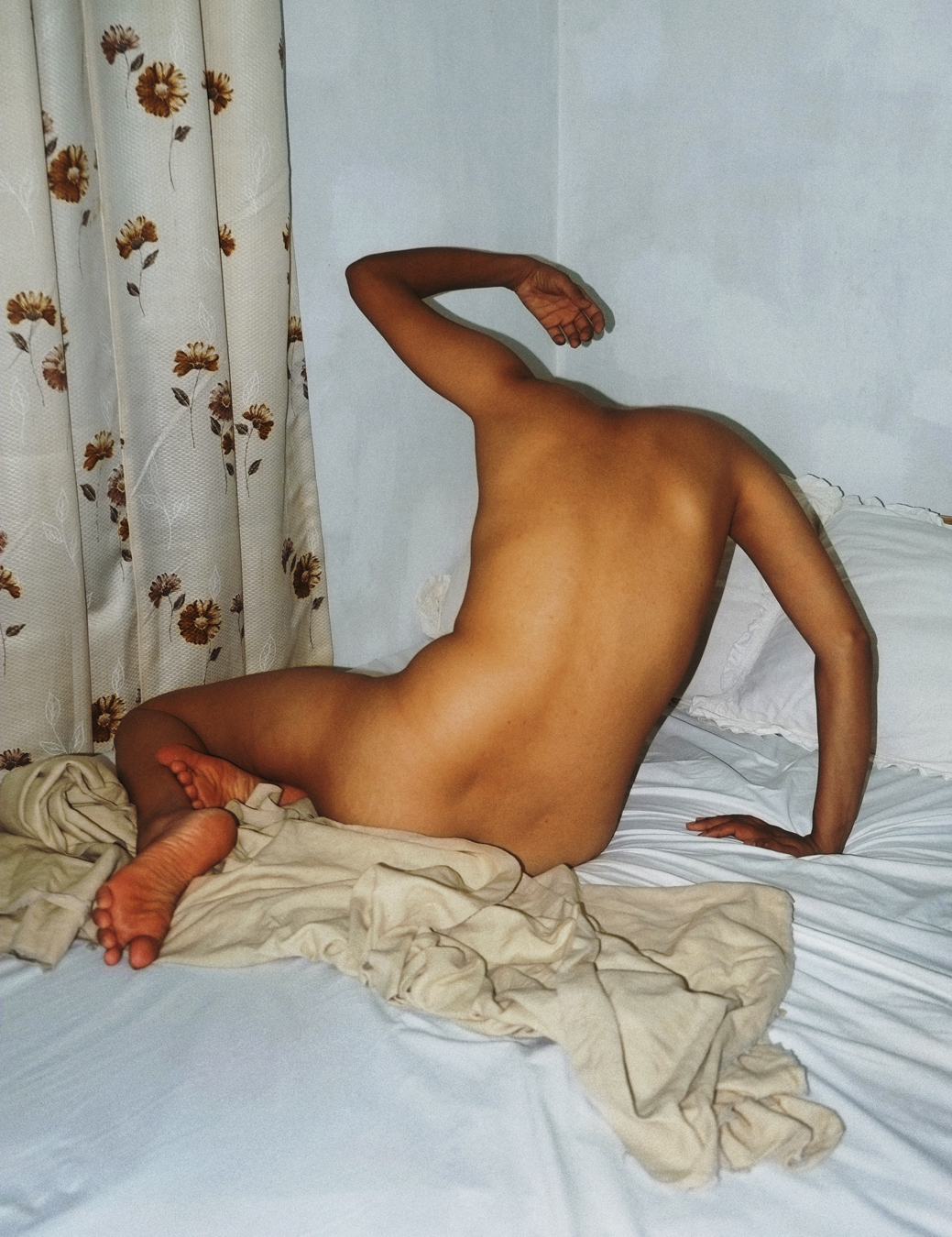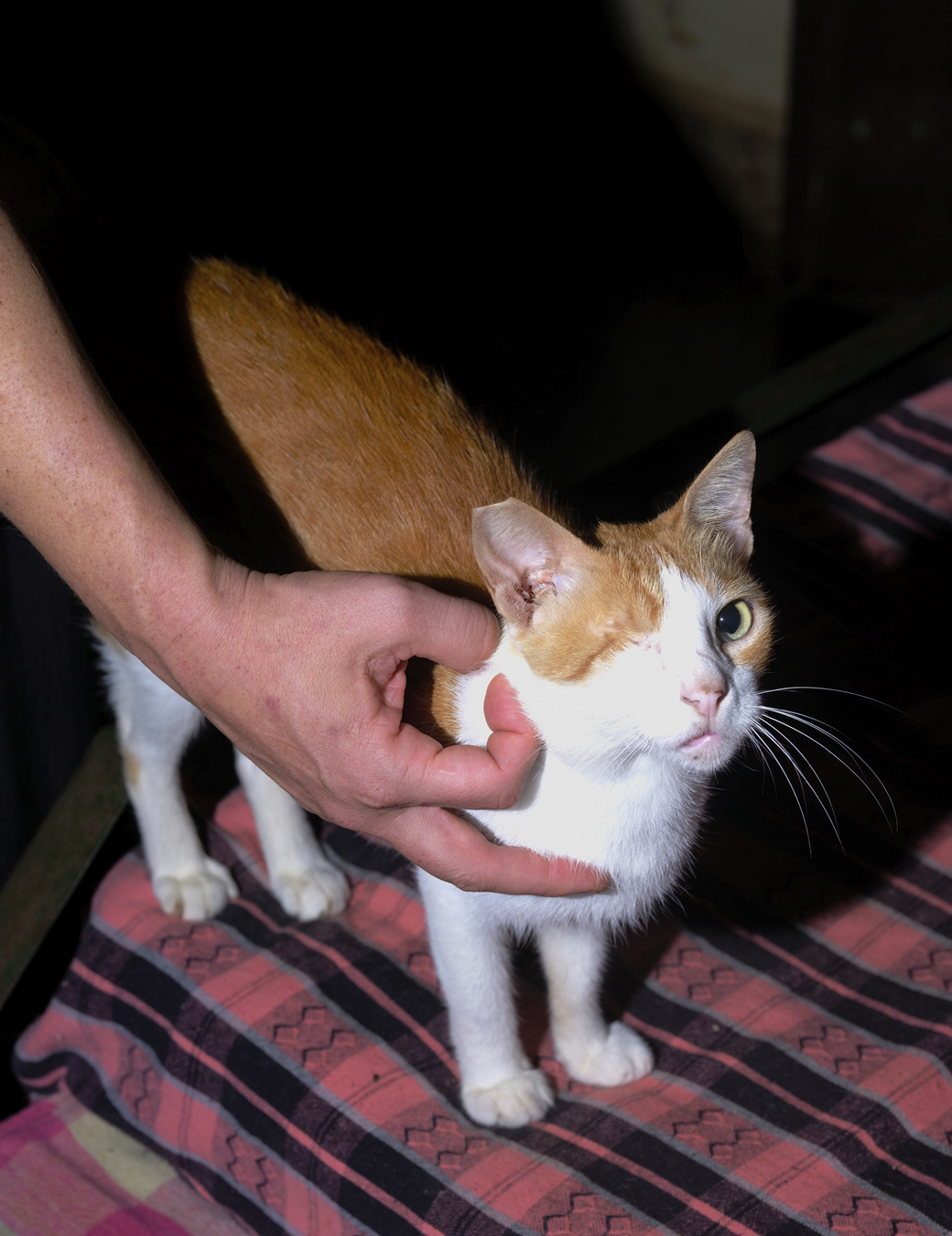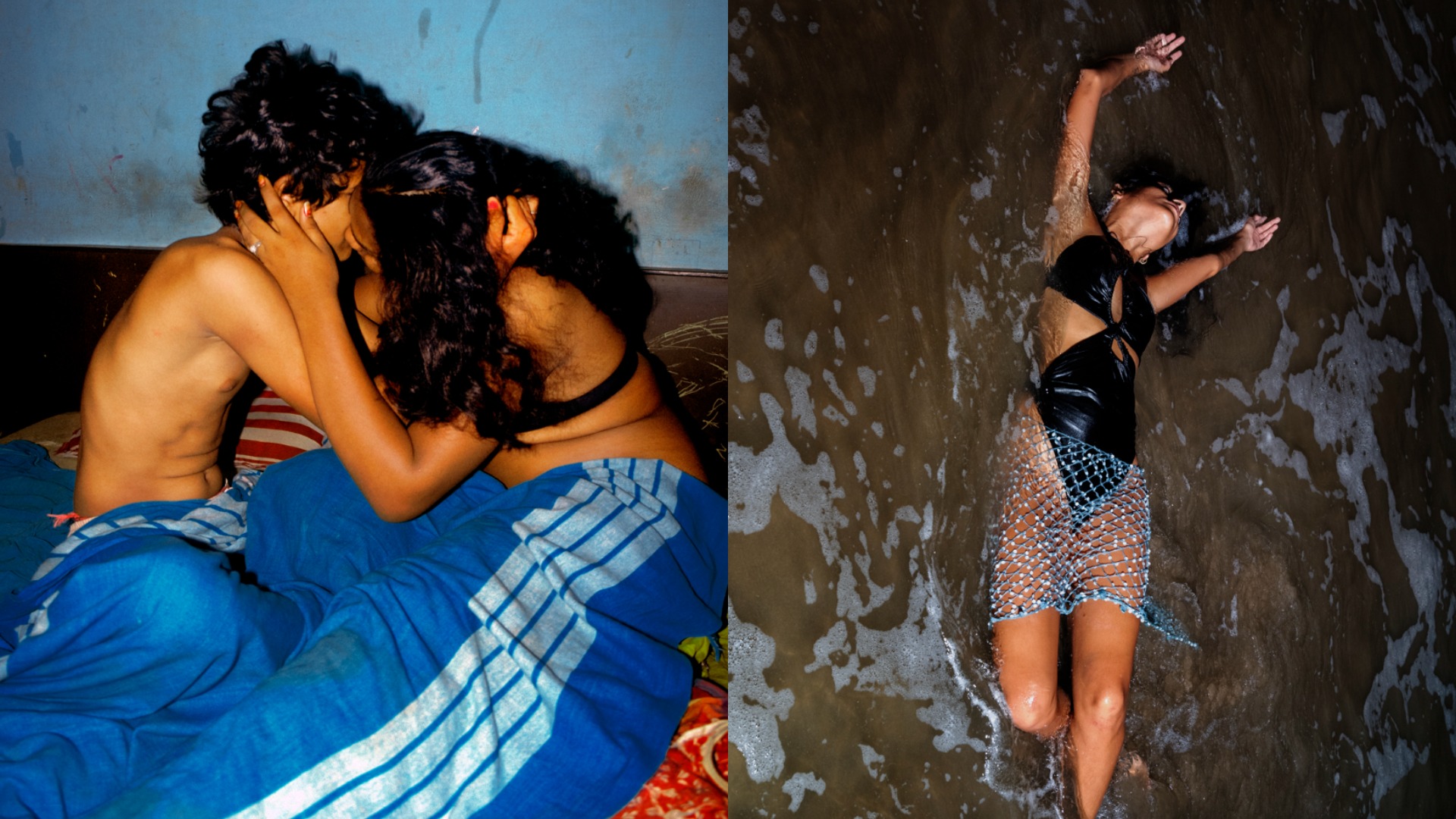This story originally appeared in i-D’s The Out Of Body Issue, no. 367, Spring 2022. Order your copy here.
A couple of years ago, Supriya Lele was given a copy of The Coast – a photographic essay of 101 pictures by Delhi-based artist Sohrab Hura. Shot in the depths of an inky night during religious festivities in a coastal village, it reveals the undercurrents of social hostility in modern India. Hura treats the line between land and water as a point of ecstatic, ecclesiastical release.
Meanwhile, with her radiantly provocative clothes, the London-based Supriya has cultivated a curious balance of Eastern Elan and European grunge. She bookends each season with a trip back to India (while she was born and raised in the Midlands, her childhood was punctuated by trips to visit family in Nagpur and Jabalpur) and, this year, her SS22 campaign was a stimulating meeting of tendencies. This conversation discusses a body of work that mixes Sohrab’s archive with new pictures of Lele’s clothes. They offer a part of Supriya’s psyche that we haven’t seen before. In the darkness and grit of Goa at night, we sense danger, but also magic and euphoria.
Dal: I’m interested in this pull that India has on you. You keep returning and shooting your collections there. Why is that?
Supriya: Taking my work back into the context of where my family are from is really important. I am literally revisiting it through my work. Otherwise, the collection is always in Europe. I show in London and sell in Paris or Milan, but it doesn’t often go back to where a lot of it is rooted. I need to touch base and re-contextualise the work. Doing it with other people helps to do that. Even though I’m a “brand” – I hate that word – and even though I’m making product, there’s always an ebb and flow in the creative process. I felt this quite intense need to pull it into India again this season, but not in the same way that I have done before, in a semi-sentimental way. It needed to feel more present, more current, more raw.
Dal: Sohrab, I see a kind of anti-romanticism in your work. I don’t think it’s necessarily the subject matter, but it’s there in the way you’re capturing the world around you. Do you see your pictures as raw?
Sohrab: When I saw Narmada – the project Supriya did with Jamie Hawkesworth in Jabalpur – I actually kind of liked it. I don’t personally want to categorise it as being romantic, but I understand where Supriya is coming from when she says that. What I noticed in all of her shoots is the presence of water. Somehow water keeps repeating itself in a lot of my work too. Supriya uses phrases like ‘ebbs and flows’, it picks up on a certain energy. I noticed that she’d worked along the river for Narmada and, of course, there’s a certain calm flow with a river. The water became a landscape to explore something with a different energy.
Dal: This is the first time you have worked with fashion, isn’t it?
Sohrab: It was a chance for me to understand the balance that clothes can bring to a picture. I’m at an interesting point with my photography because I’m thoroughly bored of it. Working on this has jump started something within a landscape I am familiar with. I knew that I wanted to shoot in the water because I know it, but I wasn’t consciously trying to make it raw. Playfulness is important to me and somehow water allows for that. It allows for something unexpected. I don’t think I’m a very good director, and very often when I have something already conceived in my mind, it turns out shit – the sea was there to rattle me a bit.
“We were interested in exploring these half-spaces where the body is hidden. Something a little more mysterious and a little more doubtful.” Sohrab Hura
Supriya: There was an energy there that definitely felt different. It feels powerful and I guess, semi-dangerous. It just felt right to go to the coast and in a more obvious way, the collection includes these fishnet embroidery pieces that were very apt, and these lantern bags. Working with Sohrab was just like vibing it out, seeing what comes. I’ve always been attracted to working with people who aren’t necessarily from a fashion background. It’s not like going into a studio set-up with hair and make-up and production where you do the shoot, and it looks great and that’s that. This is a lot more spontaneous. It’s risky. You can get magic in those scenarios.
Dal: Earlier you had a resistance to the word “brand”, why is that?
Supriya: It’s me in my studio with two assistants just trying to get things done – I prefer working in that way because it feels more creative. Thinking of yourself as a “brand” feels clinical – I just want to be a good designer and make good work.
Dal: Sohrab, you lied when you said you hadn’t shot fashion before. I would say that any image with clothing in it is pretty much a fashion image – that’s definitely how a generation is reading pictures today.
Sohrab: I would actually agree with you. It’s not necessarily a lie, but I am using the term “fashion photographer” just to isolate this experience. In the end, as you said, anything with clothes can be fashion depending on how you look at it. Even when I talk about my process, I use the words “folding” and “stitching” which are very domestic words. Today, the clothes I’m wearing have holes all over them. I feel like something not so perfect; a little broken. Torn. That’s me. It’s because of my mum that I recognise this idea of care through clothing.
Dal: I read somewhere that you took up photography as a kind of therapy to cope with your mum’s schizophrenia. Your first two books Look It’s Getting Sunny Outside!!! and Life is Elsewhere were about her.
Sohrab: Yes, and clothes became a big part of her illness. Somehow, they reflected her condition and her mental health. Those books were made at home and in them the clothes repeat according to her mood. In the end, even work like The Coast had this fashion and personality throughout it. The clothes throughout hold symbolic meaning around gender, caste, and religion. Maybe it hasn’t been that conscious in my work, but there have always been these undercurrents of meaning.
Dal: You said earlier that you were bored of your work – what do you mean by that?
Sohrab: I’ve been a bit bored with the medium of photography itself but that is a very healthy state to be in. I’ve had these repeated points of boredom where I’ve been more drawn to moving image, but it also has a lot to do with repetition. The moment I feel that something is repeating itself, it gets boring. I want to reinvent myself and keep busy – to feel playful. I think this idea of being playful with the work and taking risks is what Supriya was talking about.
Dal: How did the shoot go from your perspective?
Sohrab: We went with certain expectations, but we also wanted to leave space for the unknown, which is where the sea comes in. We consciously chose to shoot at night because that makes a landscape more unknown. You feel very isolated, but it’s also a time of magic if you allow for it to happen. We want the work to have its own feel, its mystery and moments of doubt.

Dal: How did you approach the casting? Do you see the people in the pictures as characters?
Supriya: It’s less about characters in the narrative sense. Even when casting shows, we like to see each woman as her own person in the outfit she would wear. The same goes in the campaign – they’ve each got their own identities, their own thing going on.
Dal: And we cannot see any of their faces – why is that?
Sohrab: We were interested in exploring these half-spaces where the body is hidden. Quite a few images became too much about one person, so like Supriya was saying, it was more about trying to find a seamless join between what we worked on, and the work that I’ve done in the past: something a little more mysterious and more doubtful. There’s a picture of a woman wearing a white dress standing in the sea and she is turned away from the camera. In front of her is a wave that hasn’t fully formed – you don’t know if the wave has occurred yet. We didn’t want the landscape to reveal too much either. My dilemma was – how do I justify making these photographs?

Dal: Do you mean that in terms of not wanting to repeat yourself?
Sohrab: Exactly. Am I taking a formula and creating something disjointed by projecting another work onto it? Or am I finding a thread from work in the past and extending that forward? I’ve been documenting my home for the last fifteen, twenty years. It’s a big privilege, yet one of the most difficult places to photograph because I know it too well. Nothing really sticks out. Supriya didn’t want to romanticise anything: I don’t know what that means, but at the same time, I’m conscious that there is a danger of that because we were in Goa. Everything looks beautiful. We didn’t want things to necessarily look beautiful because I think that’s often a mask that deceives us. A lot of my works have been done over a ten to fifteen-year period, so in a way it was a very artificial way to compress all that time into something.
“There’s always an ebb and flow in the creative process, and I felt this quite intense need to pull it into India again this season, but not in the same way that I had done before; in a semi-sentimental way. It needed to feel more present, more current, more raw.” Supriya Lele
Dal: Supriya – Sohrab mentioned boredom, but then he also just brought up the luxury of time. One of the biggest learnings for him is how ludicrously fast and consumptive the fashion industry is: we’re always thinking about the next picture, bag, or shoe. The pictures we’re talking about are over, you’re now onto the next collection which will be shown in a month’s time. We’re always forgetting to be in the thing, in the moment.
Supriya: It’s a tricky one because I’m somebody who gets bored really quickly. We’ll make something, and I will hate it and then might fall in love with it again later. My process is always quite last minute; I start my collections quite late. I need that pressure to cook something. I think if I had too much time, I wouldn’t put work out.

Dal: But do you crave more time?
Supriya: I always long for more time but that’s the irony of this industry! I’m always like, “if I just had one more month…” but I know I wouldn’t use it. It’s amazing and inspiring for me to hear Sohrab talk about his practice and having these long-form projects. I wish that fashion could be more present like that, because it’s only when I look back at things I’ve done that I appreciate them. At the moment, I was over it. I feel like I really have to do these creative projects with people who have different approaches because it keeps me grounded. If I didn’t, I would be churning out collection after collection and it wouldn’t feel right.
Dal: So how would you spend this imaginary month?
Supriya: I would probably over-develop work! But I do think a really important part of my process is making a lot of shit. You make mistakes and through them you learn something, or an accident happens. I’m not very good with very controlled processes, I feel like it sucks the joy out. That’s how I work – a lot happens in fittings and on the body quite quickly because it’s about what feels right.
Dal: What have you learned from Sohrab?
Supriya: He looks very deeply and intelligently at things. Hearing him talking about the symbolism of clothing refreshes my brain. It has made me feel really connected to my practice – like, okay, I can start thinking a bit more deeply about certain codes or things that I’ve touched upon in my earlier work. To check in again with myself rather than thinking you’ve just got to make a collection that has to be really cool and sexy. It has to feel more grounded and rooted in something.
Sohrab: I remember in the evenings when we were in Goa we didn’t talk about work; we talked about everything that leads to it. Supriya had this healthy angst or a kind of self-doubt. I’m always considering my work – and I presume it’s the same for her – but quite often, the work is just a residue of something much larger.
Follow i-D on Instagram and TikTok for more on fashion and photography.
Credits
Photography Sohrab Hura.
Creative direction Jonny Lu Studio.
Fashion Emilie Kareh.
Production Smita Lasrado at featartists.
Models Shimron Nathan, Shimei Nathan, Sana Thampi and Rodali Dutta.
Special thanks Magnum Photos.



